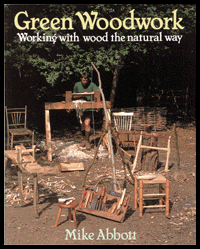

 A
book review: By Donald C. Brown
A
book review: By Donald C. Brown
Title: Green Woodwork,
Working with wood the natural way
Author: Mike Abbott
A Guild of Master Craftsman Publication
Published by: Sterling
Publishing Co. Inc.
387 Park Avenue South
New York, NY 10016-8810
ISBN 0946819181
Price Softcover: $17.95 (Canada $25.95 )
208 pages
This is not a new book, but rather a reprint of one that first appeared ten years ago. No new material made its way into this edition but that is no detriment. The tools and techniques for making simple implements and furniture from freshly hewn trees have probably not changed in many hundreds of years, much less a decade, so Mike Abbott's treatment of them is as up-to-date in 1999 as it was in 1989.
Let me get my biases out in the open at the start. While I think it is very important to understand where we came from and to appreciate the decidedly pre-industrial hand manufacturing of our forefathers, I do not take a touchie-feelie delight in imposing the constraints of a bygone era on myself. I don't want to render my own hogs for cooking fat, and kiln-dried lumber and power woodworking machines suit me just fine. The delight I take in hand-crafting furniture comes from its esthetic superiority to the factory-made sort, not the comparatively inefficient manner in which I produce it.
That said, this is an interesting explanation of the materials, tools and techniques for fashioning utilitarian objects from green wood. Mike Abbott addresses my question--Why work green wood?--at the beginning. His answer really boils down to: It's cheap. I looked in vain for some functional advantage, because surely the changes green wood undergoes as it dries could be exploited for something, but my imagination fails me on this point and Abbot didn't provide any illumination.
The book is addressed more to the interested craft amateur than to the experienced woodworker. Much of the early material is introductory-how a tree grows, how tools cut and the like. Although the author is British, and the woods he discusses are those native to his home islands, there is little about the raw material of his craft that will be unfamiliar to North American woodworkers. Language is not a barrier; the text flows smoothly, and there are few Britishisms to baffle the reader.
This is basically a chair book, and the tools Abbott discusses are the minimal kit for that craft: axes for rough sizing, saws for cutting to length, froes for splitting to proper dimensions, a few edged tools such as drawknives for shaping, and braces and bits for fashioning holes. Oh yes, and a goodly assortment of pounding implements. My favorite photograph includes a mallet that would have been instantly recognizable to a stone-age artisan.
Turnings are essential to the type of chairs Abbot favors and there is a lengthy discussion of the design and cobbling together of a pole lathe. It looks crude, but judging from the quality of turning exhibited in the chairs of the author and his students, it must work quite effectively. A shaving horse is another essential to Abbot's methods of work and a chapter is devoted to its construction.
The bulk of the actual furniture-making part of the book is occupied with chair making. While above I described the furniture of this book as utilitarian, that description was of its function-few objects are more utilitarian than a chair-and not of its appearance. Some of the seating displayed is surprisingly sophisticated and graceful. Not one to ignore any green wood element, Abbot even weaves his chair seats from strips of bark.
In the concluding pages of Green Woodwork,
a miscellany of other objects, such as eating and serving utensils,
fences, rakes, and brooms, is discussed.
Woodworking of the sort described here may not be my cup of tea,
but this is a well-produced and knowledgeable treatment of a
subject which the reader can enjoy in his or her mind's eye without
once actually having to set froe to log. And if froeing appeals
to you, here's where you'll find the basic information to get
started.
Donald C. Brown
who makes furniture from store-bought wood in Havana, Florida
Editor's Note: Sterling Publishing has graciously donated several books for review which are passed on to our members free of charge. Thank You!